新たなる研究理念を求めて
「第3常置委員会報告」
平成11年4月12日
日本学術会議
第3常置委員会
この報告は、第17期日本学術会議第3常置委員会で審議した結果をとりまとめ発表するものである。
「第3常置委員会」
委員長 岩崎 俊一 (日本学術会議第5部会員、東北工業大学長)
幹 事 北野 弘久 (日本学術会議第2部会員、日本大学法学部教授)
合志 陽一 (日本学術会議第4部会員、国立環境研究所副所長)
委 員 中西 進 (日本学術会議第1部会員、大阪女子大学長)
宮家 準 (日本学術会議第1部会員、國學院大学文学部教授)
三谷太一郎 (日本学術会議第2部会員、成蹊大学法学部教授)
小林太三郎 (日本学術会議第3部会員、埼玉女子短期大学長)
花輪 俊哉 (日本学術会議第3部会員、中央大学商学部教授)
矢原 一郎 (日本学術会議第4部会員、財団法人東京都臨床医学総合研究所副所長)
川久保達之 (日本学術会議第5部会員、桐蔭横浜大学工学部教授)
上野 民夫 (日本学術会議第6部会員、京都大学大学院農学研究科応用生命科学専攻教授)
小泉 千秋 (日本学術会議第6部会員、東京水産大学長)
齋藤 和雄 (日本学術会議第7部会員、北海道健診センタークリニック院長)
藤田 恒夫 (日本学術会議第7部会員、日本歯科大学新潟歯学部第二解剖教授)
「新たな研究理念を求めて」
-第3常置委員会対外報告概要-
1.提案の背景
新たに設けられた「戦略研究」は、第16期半ば以降における科学技術研究予算の大幅な増加の契機となった。それは同時に基礎研究、応用研究を、今までよりも広い概念で把える必要があることも明らかにした。
また、「戦略研究」の定義は科学技術の分野では理解できるが、人文科学、社会科学を含む学術研究一般には適用が難しく、それが人文・社会・自然諸科学間の乖離をさらに拡大する恐れがあることも指摘されている。
このため本報告では、我が国における学術研究の創造性を高めかつ全ての分野で均衡がとれた発展を図るために、今までの基礎研究、応用研究さらに戦略研究という分け方について改めて検討を加え、「モデル転換論」に基づく新しい研究の分類方法を提案している。
2.モデル転換論による分類
人文・社会・自然の諸科学にわたる学術研究の規範となる分類は、実際に研究が進む過程での研究者の自然な心の動きに沿った分け方であることが望ましい。
その一例として提案するのが、創造モデル研究(一次:仮説の提唱とその実証)、展開モデル研究(二次:一次モデルの標準化と普及)、統合モデル研究(三次:二次モデルの実社会への融合)による分類である。
一次から二次さらに三次への展開は、今までの基礎・応用・開発とは異り、例えば実用を目的としない、いわゆる従来の基礎に属するものでも、考え方や方法がこれまでとは同じで追試の性格を持つものであれば、それは二次モデルとなる。
一方、実用を目的とする研究でも、新しい方法を提示するものであれば、それは一次モデルと考える。また三次モデルは、一次、二次モデルの循環によって得られた研究の成果の人間社会並びに自然環境への適合の研究である。
上記の三モデル間のサイクリックな研究の見直し(図1参照)によって、学術研究の進展を図ることがこの分類の趣旨である。
3.分類が持つ効果
上述のモデルは、研究者自身の価値判断に基づく分類であるため、相互に循環する研究活動を自ずから促すことになり、その結果、従来のような基礎研究は非実用、応用研究は実用という古い殻に閉じこもった思考を変え、研究の全体を見通した戦略的思考を生むことになろう。
これは研究者の創造モデルヘの意欲をさらに強め、また戦略研究が意図した科学技術の分野におけるイノベーションの創出への研究も活発に行われることが期待される。
さらにこの分類の持つ効果は、基礎研究、応用研究あるいは戦略研究などでは包含し得ない人文、社会科学の研究にも容易に適応できるため、学術研究全体に対する共通に言葉と価値観を与えることであり、これは、科学技術基本法において“人文科学のみに係わるものを除く”とした但し書きを取り除くための第一歩になるとみられる。
4.統合科学への発展
モデル転換論に基づく研究の分類には、学術研究と、実社会との融合を目ざす統合モデルが必然的に含まれる。それは研究対象を諸科学の統合的(Integrate)な視点から把える研究方法であり、統合科学という新たな分野を生み出すことになる。
統合科学のひとつの例は「地球環境科学」であるが、これは人類及び国家の利益と科学のグローバリゼーションの両立を目ざすものであり、社会、国民の福祉と科学技術の密接な関係の上に成り立っている。自然環境、人口、食糧問題などが統合的に配慮されるべきであり、さらに生物の競争、相互作用、共生が諸科学の統合の上に論じられる必要がある。
第17期の目標である「俯瞰的プロジェクト研究」はまさに統合モデルにかかわる研究であり、それは個々の研究分野の調和を図った新しい理念と名称を持つ統合科学を生む方法である。
目次
Ⅰ 従前の経緯 -「戦略研究」の提唱
Ⅱ 「戦略研究」の問題点
1 進歩をゆがめる基礎研究・応用研究の分類
2 誤解を生む直線的思考
3 総合性を欠く「戦略研究」
Ⅲ 新しい研究分類としての「モデル転換論」
1 研究過程による分類
2 新しい分類の特徴
3 科学諸分野への対応
Ⅳ 諸科学の融合
1 統合科学
2 統合科学の理念
3 新認識
Ⅴ 新しい研究理念に求められるもの
1 研究者の意識
2 施策の必要性
3 新分野の開拓
4 研究制度の充実
付録1 総務庁科学研究調査における研究の分類
付録2 「新たな研究理念を求めて」の報告にあたって(経過説明)
付録3 報告の英訳
新たなる研究理念を求めて
-「戦略研究」から「新モデル研究」へ-
日本学術会議 第17期第3常置委員会
Ⅰ 従前の経緯-「戦略研究」の提唱
1995年4月、第16期日本学術会議の第121回総会において、今までの一般的な基礎研究と応用研究の間に新しい研究カテゴリーとして戦略研究(Strategic
research)をおくことが伊藤正男会長(当時)から提案された。この提案は欧米諸国の同じような動きと相まって、いくつかの討論の結果、日本学術会議の公式の見解と認められた。第15期までの、とくに応用を意識しない基礎研究を重視してきた日本学術会議にとって、これはきわめて新しい動きであった。
そこで、各省庁でもこの動きを受けて、1995年11月に公募型研究プロジェクトが発足し、また政府は1996年6月に、科学技術基本計画として長期的な政府投資を継続して行うことを決定した。
このような経緯からみて、戦略研究の提唱は明らかに最近における科学技術政策の活発な動きの引き金になっており、国の政策に及ぼした効果の上で、第16期日本学術会議の活動の大きな成果といえるだろう。
その後、日本学術会議においても、戦略研究の内容を「長期的にみて応用の潜在力のある研究」(伊藤前会長)あるいは「実用を目的としながらしばしば基本問題にまで遡って進める必要がある研究」(岩崎俊一会員)、さらに「基本問題の解決を目的としながら常にその応用を探る研究」(和田昭允会員)などとする見解が、『学術の動向』誌(1996年4,9月号、1997年10月号)に公表された。
しかし、戦略研究が、基礎と応用の研究を相互に結びつけるものであることはほぼ共通の認識だとしても、さらにより深い解釈、あるいはその名称の与え方などについては、いまだ検討の余地がある。また学術研究を、基礎、戦略、応用、さらに開発、試験というように、細分化していってよいのかという疑問も残る。
そこで第17期第3常置委員会では、国の施策としての戦略研究の持つ意義を十分認めつつも、学術研究の規範としての戦略研究の概念を明確にすることから出発し、さらにこれを発展せしめることを課題としてきた。
Ⅱ 「戦略研究」の問題点
1 進歩をゆがめる基礎研究・応用研究の分類
基礎研究、応用研究、開発研究は日本における一般的な研究の分類である。科学技術基本法もこの分類を採用して基礎研究の積極的な振興をうたい、日本学術会議でも第15期まではおおむねこの分け方に沿って学術研究を考えてきた(本文の末尾に総務庁科学技術研究調査の説明を添記する)。
また、いわゆる「基礎研究ただ乗り」、たとえば日本の科学技術と産業が外国の基礎研究の恩恵の上になり立っているといった非難に代表されるゆがみを解消し、日本における科学技術の創造性を高めるためには、直接応用を目的としない基礎研究を振興することが必要だという意見も、今まで数多く出されてきた。
しかし、このように学術全体の研究を基礎、応用、開発(そして新たに戦略研究が加わる)と細分して固定化する分け方自体が、学術の進歩をゆがめてきたのではないだろうか。
その進歩とは具体的にいえば、学術研究における斬新な学説や科学技術におけるイノベーションの創出等である。
いままで、日本からの貢献によって世界の学術の研究や科学技術が革新された事例は少なく、主として事後の改良に日本の研究が集中しているために「基礎研究ただ乗り」の非難が起こっていることを、まず直視する必要があるだろう。
2 誤解を生む直線的思考
もう一つの問題点は、この分類によって基礎研究を進めれば、時間はかかっても応用研究が生まれ、それが役に立つ開発研究に直線的につながっていくという誤解を生むことである。
科学技術におけるさまざまなイノベーションの実例を調べると、まず実際問題の科学的な重要性に着目すること、次いでそれに関連する基本的な現象について研究を進めることが、応用の面で大きな進歩をもたらす、もっとも良い方法であることがわかる。
すなわち、最初に何を創り出すかという研究者の明確な目的があり、それを実現するための試行錯誤の中で、新しい現象や考え方の発見をもとにした深い研究が行われ、それがイノベーションを創るのである。
たしかに戦略研究は、学術研究の在り方に対する社会の一般常識に合致し、第16期半ば以降に学術研究予算の大幅な増額を実現した。しかし同時に、基礎研究、応用研究を今までよりも広い概念で把える必要があることも戦略研究は明らかにした。各省庁がとり上げたプロジュクト研究に、未来開拓学術研究、戦略的基礎研究、独創的産業技術研究などの名称が使われていることも広い概念で把える必要性を表しているであろう。
米国でも、やや趣旨は異なるが、研究分類の見直しが進められている。競争力委員会(Council
of Competitiveness、1986年設立)はポスト1945年体制における基礎、応用、開発という直線的な区分が、現在では技術革新の現実から離れて非生産的な政治的論議を生んでいるとし、研究のタイプを、その結果が期待できる期間を考えて、短期的/低いリスク(3年)、中期的/中程度のリスク(4~6年)、長期的/高いリスク(7年以上)の三つに分けることを提案している。
短期、中期の研究主体は産業界であり、長期的研究は大学と政府が主体で産業界が協力する。ここで長期的とは何らかの実用目的を秘めたものか、基礎的な科学知識を高めるものとされている。米国らしいプラグマティックな分類ではあるが参考の一つになるであろう。
3 総合性を欠く「戦略研究」
新しい「戦略研究」という定義は、科学技術の分野はともかくとして、人文、社会科学を含む学術研究一般には適用が難しく、それが人文、社会、自然 諸科学間の乖離をさらに拡大する恐れも大きい。
戦略研究という新しいコンセプトの出現にともない、学術研究における均衡のとれた発展を図るために改めて今までの基礎研究、応用研究という分け方について検討を加える必要があるといえる。
Ⅲ 新しい研究分類としての「モデル転換論」
1 研究過程による分類
そこで、前述のような観点に立つと、人文、社会、自然の諸科学を包含する学術研究の規範となる研究の分類は、もっと単純でかつ柔軟なものであることが望ましい。
もっとも自然な分類は、実際に研究が進んでいく過程での研究者の心の動きに沿った分け方で、その一例が次に述べる創造モデル研究(一次)、展開モデル研究(二次)、統合モデル研究(三次)による分類である。それぞれの属性を示すキーワードを添える。
ここで言う「一次、二次、三次」とは、学術の研究が国の文化をつくる段階を三つにまとめたものである。各段階は文化形成において同じ価値を持ち、歴史的にも並行し相互作用することもあり、上下の関係を示すものではない。
学術研究の新しい分類
創造モデル研究[一次モデル]:仮説の提唱と実証
斬新、主体(主観)的、知る・見付ける
本質的に無競争
展開モデル研究[二次モデル]:一次モデルの標準化、普及(学習)
精密、客観的、構想する・造る
競争的
統合モデル研究[三次モデル]:二次モデルの実社会への融合
社会性、人間性、倫理的
協調的
図1は各モデル間における研究の見直し、すなわち相互の循環の方向(矢印)と強さ(実線と点線)を示したものである。
一次と二次、二次と三次間の実線は数多くのサイクリックな研究の見直しを示し、また一次と三次間の点線は、学術の創造性に対する社会からの過度な抑制を避けるという意味をもっている。
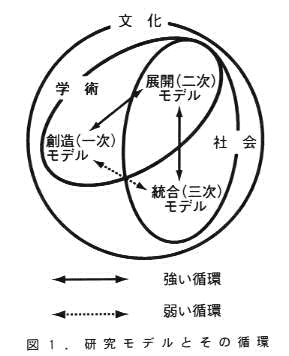
Ⅳ 諸科学の融合
1 統合科学
一方、人文科学、社会科学、自然科学という分類によって研究分野を排他的に区別することも、一つの形式にすぎない。一つの未知の事象を前にして動く心の働きはもっと広いはずであり、事象自体が人文的、社会的、自然的に孤立して存在するのではない。そこで、研究者の心の動きに沿った「モデル転換論」に適合する科学自体のあり方も検討されなければならなくなる。諸科学をさらに融合させ統合することは可能であろうか。従来、人文、社会、自然の「諸科学の総合」といえば諸分野の寄せ集めか、境界領域を扱う科学を意味したが、分野のモザイクや総合(generalization)にとどまらず、研究対象を統合(integration)してとらえる必要がある。これをいま「統合科学」と称する。
2 統合科学の理念
統合科学はなによりも「文化創造の基礎としての科学」を理念とするものであり、それにふさわしい主題と適切な方法、そのことから構築される理論が求められる。そもそも、学問はかつて哲学であった。研究者の統合的な志向に支えられ、方法を自己抑制的に限定しない態度の中で、現実の諸事象を知の秩序の中に意味づけることを統合科学と考える。
いま統合科学のひとつとしそ「地球環境科学」を例とすることができる。これは人類および国家の利益と科学のグローバリゼーションの両立を目指すものであり、社会、国民の福祉と科学技術との密接な関係の上になりたつ。人口、食糧問題などが統合的に配慮されるべきであり、生物の競争、相互作用、共生が諸科学の統合の上に論じられる必要がある。生物資源によるポスト石油体制を構築することも、そのひとつであろう。
また「俯瞰型研究プロジェクト」(1999年1月、吉川弘之現会長特別談話)は、まさに前述の分類による統合モデル(三次)にかかわる研究であり、それは従前の個々の研究分野の調和を図った新しい理念と名称をもつ統合科学を生む有力な方法のひとつといえる。
3 新認識
文化創造としての統合科学を構築するためには、従来別個に考えられてきた諸科学を横断する「新認識」が必要となる。たとえば、人間の心や社会現象、物質万般にわたる「ゆらぎ」は、宗教学では「始源回帰」とよばれるが、一方、物理学では、あらゆる観測量は平均値のまわりに「ゆらいでいる」という意味で、「ゆらぎ」は統計力学め重要な概念になっている。人文科学の立場から見ると、人の心や生物の行動は「ゆらいでいる」ことが本来的であり、生きていることの証しであるとも考えられているが、物理学において「ゆらぎ」は少なくともニュートン力学の立場では、外部からランダムな力を与えない限り起きないものと考えられてきた。しかし生物のようなエネルギーを絶えず取り込む、いわゆる非平衡開放系を扱う場合には、新しい発想が必要であろう。もっとも近年、数学や物理で盛んに取り上げられている「カオス」という概念があって、それは、いくつかの変数が非線形結合した系において、外部からの刺激なしに実現する予測困難な変動現象であるが、これが生物の本来的な「ゆらぎ」の説明になるかどうかは、今のところ分っていない。一方、東洋には「ゆらぎ」と生命や物の存在の関係を論じている荘子の「物化」の思想がある。物はかぎりなく溶解しながら、厳然としてそれぞれに物であると荘子は考える。
このように同じ言葉で表される「ゆらぎ」という概念も、異なる学術分野ではさまざまなニュアンスをもっている。21世紀の学術が進む方向の一つとして、諸科学がこれまでにそれぞれ育んできた諸概念について、互いに他を理解し、影響しあい、「新概念」を構築していく横断への努力をし、統合科学の樹立を目指すべきである。
Ⅴ 新しい研究理念に求められるもの
1 研究者の意識
以上のように日本の学術研究が、それぞれの学問分野の将来あるべき姿について明確な構想をもつことは、「基礎研究ただ乗り」の非難を解消する方法であり、それには研究の分類と評価についての研究者個人の意識改革が基盤とならなければならない。
2 施策の必要性
創造的なテーマによって研究を行うことは、学術研究の進展のみならず、ひいては国の存立にかかわる緊急な課題といえる。
そめために必要なものは、既知の共通の課題だけではなく、創造的なテーマを見つけ、解き、それを展開していくという研究者の一次、二次、三次モデルにわたる研究を積極的に支援する国家の姿勢であり、さらに我が国の学術研究の創造性を高め、実のある国際貢献を行うために、学術全般の動向及び社会の現状を総合した確かな政府の施策が必要である。また、それを支援する充分な学術研究環境をつくるべきである。
3 新分野の開拓
もともと戦略研究の言葉は、近代科学の創造に実績のある英国でそれを産業に広げようという発想から出ている(1993年、メージャー政権)。そこで、今まで技術開発の盛んな日本では、実用的なテーマの中から新しい科学技術の芽を創り出していくという発想を含むべきだと考える。
我が国が得意とし、かつ尊敬が得られる学術研究の分野を増やし、それらを核として人類共通の文化の進歩に貢献することこそ、すべての研究者に期待される目標である。
4 研究制度の充実
以上述べた自発的でいきいきとした研究によって、未来の人類、国家に貢献していくためには、具体的に次のことを考える必要がある。
ア 新たな研究理念に基づく、科学技術会議を設ける。
イ 科学技術研究における大学、研究機関の役割りを明確にすること。
ウ 新たな研究理念を求める研究者を育成し、十分な研究費を充当すること。
また、ますます必要となるであろう統合科学にそなえて、統合化の芽を育てる教育科目が初等教育の段階から必要であり、すべての生徒、学生に諸科学を広く学ぶ機会をあたえ、多様な人材を育てる教育法を採らなければならない。
中央省庁改革の一つとして、現在総合科学技術会議の設置計画が進んでいる。これはアの考えと一致するが、何よりも「統合科学」の理念を明確にすることが望ましい。したがって、人文、社会、自然の諸科学の均衡を目指すならば、日本語の語義の上からは“総合”よりは“統合”が適当と思われるが、しかし本報告の趣旨が含まれるなら、第3常置委員会としてとくに名称にはこだわらない。
【付録1】
総務庁科学技術研究調査における研究の分類(統計調査は昭和28年以降実施)
◇基礎研究
特別な応用、用途を直接に考慮することなく、仮説や理論を形成するため、もしくは現象や観察可能な事実に関して、新しい知識を得るために行われる理論的または実験的研究
◇応用研究
基礎研究によって発見された知識を利用して、特定の目標を定めて実用化の可能性を確かめる研究、および既に実用化された方法に関して新たな応用方法を探索する研究
◇開発研究
基礎研究、応用研究および実験の経験から得た知識の利用であり、新しい材料、装置、システム、工程の導入または既存のこれらのものの改良をねらいとする研究
【付録2】
「新たなる研究理念を求めて」の報告にあたって
第3常置委員会は第129回総会において、表題に示す中間報告を自由討議における委員長の講演により行った。
この報告は「学術の動向」総会特集(第3巻12号、1998年12月)で委員長の所見として述べているように、概ね出席会員の賛同を得たものと考える。
討議の席上、所一彦会員(第16期第3常置委員会委員長)から、本報告は科学技術政策の決定や研究の自己点検・評価に機能すると思うので、なるべく早い時期に正文化して各部、研連の討議に委ねるべきとの意見が表明された。
第3常置委員会でもそれが全体の雰囲気と判断したので、その後文章の細部の訂正と一部の加筆を行い、この第3常置委員会報告を作成した。
先の中間報告に加えた部分は
◇ 研究モデルとその循環を示す図1とその説明(Ⅲ、1)
◇ 総合科学と俯瞰型研究の関連(Ⅳ、2)
である。
第3常置委員会では報告では、別途、最近の学術政策に基づく予算措置の将来を見とおした効果、および若手研究者をとりまく研究環境の考察をまとめるための検討を行っている。
なお、本報告に関連して、吉川会長の依頼により、1999年2月5日にフィンラン-アカデミーのセミナー"Global
Science"で日本代表として講演を行っている。創立50周年を記念するセミナーで、当日のプログラム(別紙)と講演原稿を添付した。
その内容は、中間報告を英訳したものであるが、序文に日本学術会議の概要、および日本における科学技術予算、戦略研究などの動向を示す資料を末尾に加えている。
中間報告で提案した研究モデル論は、概ね出席者の共感を得た。
【別紙】
Global Science
Seminar Ⅰ of the President of the Academy
of Finland
Helsinki Hall in the Finlandia Hall, Helsinki
Friday, 5 February, 1999
Programme
The seminar will be in English with simultaneous
interpretation into Finnish.
Chair: Professor Reijo Vihko, President of
the Academy of Finland
10:00 Opening words, Mr. Olli-Pekka Heinonen,
Minister of Education
10:10 Morning lectures
・Life Science in 2050, Academician
Lennart Philipson, Sweden/USA
・Biological Sciences - From Basic
Discovery to Pharmaceutical
Application, Professor Jonathan Knowles,
F. Hoffmann-La Roche Ltd.,
Switzerland
・The Future of the Social Sciences
in Society and Science,
Academician Erik Allardt, Finland
12:30 Lunch
14:00 Piano duo by Erik T. Tawaststjerna
and Hui-Ying Liu
14:30 Afternoon lectures
・Science and the Developing Countries,
Professor C. Wayne Bardin, USA
・The Direction of Science in Japan,
Professor Shun-ichi Iwasaki,
Tohoku Institute of Technology, Japan
16:00 Discussion
16:30 Reception in the Helsinki Hall foyer
ACADEMY OF FINLAND
【付録3】
Seminar of the Academy of Finland, February
5, 1999
A New Direction of Science in Japan
- from "Strategic Research" to
"Model Research"
Shun-ichi IWASAKI*
*Chairman, The Third Committee, The 17th
Science Council of Japan. President, Tohoku
Institute of Technology,
Sendai 982-0831, Japan
Ⅰ. Introduction
The Science Council of Japan was established
in 1947 to represent scientists in Japan.
The Science Council is directly responsible
to the Prime Minister of Japan. At present,
210 members are elected representing 89,000
scientists in the cultural and social sciences
and 607,000 scientists in the natural sciences.
The main duties of The Science Council are:
1. To promote key issues of the sciences
and counsel the government with policies.
2. To achieve close communication between
scientists in Japan and the world in academic
research on the cultural, social and natural
sciences.
The Science Council of Japan has promoted
cooperation with international academic organizations,
dispatched representatives to important international
conferences, cosponsored and supported conferences
held in Japan and abroad, and so on. My presentation
today at the Academy of Finland Seminar on
"Global Science" is such an activity
of The Science Council of Japan. The theme
of my lecture is "Science in Japan".
However, to describe the condition of all
sciences in Japan is too difficult. Instead,
I will make a talk on what guidance is underway
for promoting scientific research in Japan.
In October 1998, I had the opportunity
to make a keynote address to the 129th general
meeting of The Science Council of Japan.
The title of my presentation was "New
Concept for Research - from Strategic Re-search
to Model Research". The talk was focused
on describing a new direction and a fundamental
idea for the promotion of science in Japan.
The presentation was an interim report of
The Third Committee and the opinion was supposed
to meet with the approval of a large number
of the members on that day. Accordingly,
I will introduce you to the contents of this
report, and I would appreciate comments from
European scientists who have a long history
of significant scientific creations and achievements.
This is a golden opportunity for me as a
scientist of Japan.
Ⅱ. The Proposal of "Strategic Research"
In April 1995 at the 121st general meeting
of The 16th Science Council of Japan, Dr.
Masao Ito, president, proposed "strategic
research" as a new research category
to be placed between traditionally accepted
basic and applied research. After many discussions,
his proposal was accepted as the official
view of The Science Council in accordance
with similar trends in Europe and the U.S.A.
This new introduction of "strategic
research" was an epoch-making event
for The Science Council of Japan, which had
previously regarded basic research, without
any purpose of application, as the most important
research activity.
Stimulated by this new definition of scientific
research, every ministry and agency of the
Japanese government initiated public "strategic
research" programs open to the private
sector in November 1995. Moreover, the government
decided in June 1996 to provide long-term
government investments as a fundamental plan
for future support of science and technology
in Japan. Therefore, the proposal of introducing
"strategic research" can be regarded
as a great achievement of The 16th Science
Council of Japan because it had a major effect
on national policy for continuing support
of science and technology in Japan.
Several opinions were expressed by members
of the Council such as that "strategic
research" can be defined as "research
that has long-term potential for application"
(Masao Ito, April 1996), and "research
that must look back to fundamental issues
to find the purpose of practical use"
(Shun-ichi Iwasaki, April 1996), and "research
that always seeks applications to solve basic
problems" (Akiyoshi Wada), were published
in the official journal, Trends in the Sciences,
of The Science Council of Japan.
Although it is commonly recognized that
"strategic research" should be
an interactive combination of basic and applied
research, the proper name is still open for
discussion. Furthermore, how best to subdivide
scientific research into categories such
as basic, strategic, applied and development
is not yet clear. However, realizing the
significance of "strategic research"
for government policy, The Third Committee
of The 17th Science Council of Japan intends
to further clarify and develop the idea of
"strategic research" for the guidance
and promotion of scientific research in Japan.
Ⅲ. Problems Implied in "Strategic Research"
1. Classification into basic, applied and
development research obstructs progress
Basic, applied and development research
have been the generally accepted classification
of scientific research in Japan. The Science
and Technology Basic Law that was recognized
at the National Assembly in October 1995,
adopted this subdivision. Such a classification
implies positive promotion of basic research
and was accepted until the 15th Council.
In addition, many opinions today have been
expressed that the pro-motion of basic research
that is not directed towards any application
may have been necessary for increasing the
creative power of sciences of Japan. This
was thought as a way to respond to the criticism
of a "free ride on basic research"
since the advancements of Japanese science
and technology have been based on the benefits
derived from the basic research performed
in foreign countries.
However, true progress of sciences and
technology in Japan may have been obstructed
by such a classification that attempts to
subdivide all sciences into basic, strategic,
applied and development research. Progress
means that an original theory in science
leads to an innovation in technology. Few
cases can be identified in Japan that have
contributed to innovation in scientific research
and technology. The real blame of "appreciation
of new knowledge without any contributions"
is rooted in the fact that Japan has biased
basic research only for the purpose of achieving
improvements of ex-post-facto innovations.
2. Misunderstanding induced by classification
of research
Another problem associated with the classification
of scientific research into basic, strategic,
applied and development is that it leads
to a misunderstanding that basic research
will eventually lead to applied research
which can be directed for practical development.
By investigating innovations in science and
technology, it can be shown that the best
way to achieve creation of innovation in
technology is first to notice the scientific
importance of practical problems and then
second to perform research on the related
fundamental phenomena.
Arguments for "strategic research"
have been met with much expectation and have
resulted in drastic increases in the budget
for scientific research after the middle
of the term of the 16th Science Council in
1996. At the same time, however, it was recognized
that it is necessary to approach basic and
applied research with a broader concept than
before. This need for a broader concept is
suggested by how Japanese government ministries
have named their "strategic research"
programs : "Research for the Future
Program", "Core Research for Evolutional
Science and Technology", "Program
for the Creative Industrial Technology Research
and Development", and so on.
Reconsideration of the classification of
research has also occurred in the United
States. The Council of Competitiveness (founded
in 1986) recognized that the classification
of basic, applied and development in the
post-1945 era caused unproductive political
discussions apart from technological innovation.
Accordingly, it was proposed that research
should be divided into three categories taking
into account the time period required for
achieving promising results ; (1)the short-term/low
risk(3 years), (2)the middle-term/moderate
risk(4 to 6 years), and (3)the long-term/high
risk(over 7 years).
Industry is mainly occupied with short-term
and middle-term research, while universities
and government are responsible for long-term
research with the cooperation of industry.
In this case, long-term research should have
some practical goals for technology as well
as some enhancement of fundamental scientific
knowledge. This pragmatic classification
of research used in America can be a useful
reference for Japan.
3. "Strategic Research" is difficult
to apply to liberal arts and social sciences
Other than the areas of science and technology,
it is difficult to apply the new definition
of "strategic research" to general
academic research in the areas such as the
liberal arts and social sciences. It is feared
that further estrangement may occur between
the cultural, social and natural sciences
so that classification of basic and applied
research should be reexamined for achieving
a balanced development of academic research.
Ⅳ. "Model Research" as a new classification
of research
1. Classification by research processes
From the above point of view, it is desirable
that any new model of classification of academic
research which includes cultural, social
and natural sciences needs to be much simpler
and more flexible. The most natural classification
should follow the mental process of researchers
in performing actual research :
First: Creation Model Research,
Second: Development Model Research,
Third: Integration Model Research.
The key words for each classification are
as follows:
Creation Model Research (First Model) : Proposal
of hypothesis and verification
Original, Unconventional, Recognize/Discover,
Noncompetitive
Development Model Research (Second Model)
: Standardize and popularize
Precise, Objective, Design/Make Competitive
Integration Model Research (Third Model)
: Integration with the real world
Social, Humanity, Ethical, Cooperative
2. Features of the new classification: "Model
Research"
The classification of research from the
first (creation), second (development), and
third (integration) models demonstrates the
three logical steps of the academic research
process that distinguished it from the traditional
classification of basic and applied research.
Research that does not seek practical uses
and is traditionally classified as basic
research may be included within the second
model (development) research as long as the
idea or the method follows previous studies
and seeks precise follow-up examinations.
On the other hand, research for practical
use can be. classified in the first model
(creation) research if it proposes a new
method. The first model (creation) research
and the second model (development) research
can include the traditional categories of
basic and applied research depending on the
objectives, methods and results of research.
The correct recognition of these models will
be the first step in developing a "strategic
model" of research. The third model
(integration) research is the process that
academic research that can be regarded as
integrating research cycling between the
creation and the development models such
as that integrated by the human society and
the natural environment.
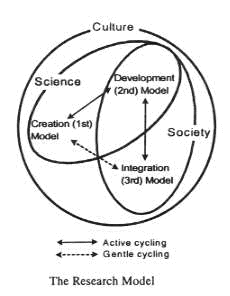
Ⅴ. Integration of the Sciences
1. Integration of science and its philosophy
Classification of research fields exclusively
into the categories of cultural, social and
natural sciences is merely one of several
possible formalisms. The human mind confronting
an unknown phenomenon should have a much
wider spectrum than that provided by each
category and no phenomenon exists isolated
alone culturally, socially or naturally.
Therefore, existence of science that conforms
to the "Model Research" classification
as being in accordance with the mental process
of researchers, should become the issue to
be considered. Is it possible to integrate
science and its philosophy? Integration of
cultural, social and natural sciences traditionally
means putting these areas together and dealing
with the border areas, but every research
objective should go beyond that and be dealt
with in an integrated way. This is the fundamental
meaning of the term "integration of
sciences".
The integration of sciences is based on
the idea that "science serves as the
foundation for the creation of culture".
Therefore, it requires a suitable theme,
the appropriate methodology and the theory
constructed with them. Science was originally
philosophy at the very beginning of human
learning. Supported by the integrating nature
of a researcher's mind that does not restrict
methods or suppress creative thinking, the
integration of sciences is defined to give
meaning to the phenomenon of wisdom.
2. Environmental earth science
"Environmental earth science"
is an example of the integration of sciences.
This science aims at compatibility of the
benefit of human beings and nations with
the globalization of science, standing on
the close relation between "social and
national welfare" and science and technology".
The population, food and other global problems
should be considered in an integrated way,
and the competition, interaction and symbiosis
of living creatures should be discussed globally
in integrating the various sciences. The
construction of the post-oil culture using
biological resources is one example.
Furthermore, the discussions on the wide-view
based project research (proposed by Dr. H.
Yoshikawa, the president) have already started
as one of the schemes to reach the integration
of sciences. The goal of research is not
only to produce desirable (we call it the
positive effect), but also to find out as
early as possible the occurrence of the negative
effects and to develop the restraint and
means to remove the negative effects by the
end of a research project. Such a wide view
of research is necessary, for instance, in
recent studies of organ transplant, cloning,
virtual reality, greenhouse effect, and so
on. Each research project should be conducted
by a group of researchers from the targeted
research field along with the influenced
fields as recommended to the organization
by the Science Council of Japan. In this
way, the cooperation between the both fields
can be decided independently by the project
organization itself.
3. New recognition
In order to construct the integration of
sciences which can sustain the progress of
human culture, a "new recognition' is
required that crosses over views separating
the various sciences which have been considered
individually in the past. For instance, "fluctuation"
in the human mind, social phenomena, overall
materials, is called "returning to the
origins" in the science of religion,
while in the physical sciences, "fluctuation"
is an important concept in statistical mechanics
in the sense that all that is observed "fluctuates"
around a mean value. From the standpoint
of cultural science, the human mind and the
behavior of living organisms are essentially
"fluctuating", and that is thought
to be the proof of living, while, in physics,
however, "fluctuation" has been
thought to never occur without external stimulation.
In recent years, the concept of "chaos"
is enthusiastically used in mathematics and
physics, but this means an unpredictable
fluctuation phenomenon that happens without
an external stimulation. However, it is not
known yet whether or not this can be an explanation
for the intrinsic "fluctuation"
of living organisms. On the other hand, the
Orient has Chwang-tse's idea of "all
things change" which integrates the
relationship between "fluctuation"
and the "existence of life and matter".
Chwang-tse's thought is that matters are
dissolves yet undeniably existing.
In the way, the concept for the same term
"fluctuation" has various nuances
depending on the different areas of science.
As an academic direction for the 2lst century,
each scientific area needs to make an effort
to construct "new concepts" by
mutual understanding and influencing other
concepts of science cultivated in various
areas. The integration of science is a cross-sectional
study directed toward such a new recognition.
Ⅵ. Proposal of new researchers and policy
1. Necessity of new researchers
In order to become free of the criticism
"free ride on basic research",
it is necessary to cultivate new researchers
who have a clear idea of what each academic
research area in the future should be, but
also a deep understanding of the importance
of the integration of sciences. The generation
of new researchers should implement the new
"Model Research" classification
and the "Integration of Sciences"
in cultural, social and natural sciences.
2. Necessity of policy
Performing research on creative themes is
an urgent necessity for not only achieving
progress in academic research but also for
the survival of the Japanese nation. What
is needed for this purpose is a broadminded
research attitude toward the creation, development
and integration models discussed above to
find, solve, and develop creative themes,
not dwelling simply on what is commonly known.
This requires a policy that integrates academic
trends in the sciences and the real status
of society in order to enhance creativity
in academic research and make a substantial
international contribution. A sufficiently
supportive environment for enhancing academic
research must be provided.
3. Development of new research areas
"Strategic research" originally
came from the idea to extend scientific creations
to the industries in Britain in 1993 by the
Major administration. England is honored
with achievements of modern scientific creations.
Although technological developments have
been popular in Japan, "strategic research"
should be included that will create new scientific
technology even from practical research themes.
The new classification of "Model Research"
is a natural way that will generate true
advancements of the sciences. To develop
new research areas in which Japan has superiority
and obtains respect and contributes to progress
of human culture are exactly what is expected
by all researchers.
4. Enrichment of a new education and research
environment
To provide enrichment of a new research
and education environment, we must:
A. Establish an organization for the integration
of science and technology in the government.
B. Clarify the role of universities and research
organizations in the research of science
and technology.
C. Educate new researchers and appropriate
research funds.
Since it will be necessary to prepare for
the integration of sciences that will be
in strong demand in the future, education
must provide all students with opportunities
to learn cultural, social and natural sciences.
New teaching methods must be adopted that
encourage diversely talented people to help
in the implementation of "Model Research".
Ⅶ. Conclusion
The discussions on the direction of sciences
in The Third Committee, The Science Council
of Japan resulted in the following conclusion:
1. "Model Research" is proposed
as a new classification of research for whole
science.
2. This new classification will stimulate
the interactive cyclic research activities
between all the models, which leads to integration
of sciences.
3. Integration of sciences will produce new
recognition that crosses over various sciences.
Although the result was interim, it was
supposed to meet with the approval of a large
number of the members. Therefore, I am convinced
that the science and technology in Japan
will progress with the fundamental idea at
least for substantial years from now. I myself
will endeavor for it.
Acknowledgments
The author wishes to express his great appreciation
to The Academy of Finland for inviting him
to present at the first Seminar.
------------------------------------------------------------------------------------------------------
Shun-ichi IWASAKI was born in Aug. 3, 1926 and received his
BS and Ph.D. degrees in Electrical Communication Engineering
from Tohoku University, Sendai, Japan. He
is now president of Tohoku Institute of Technology,
member of the Science Council of Japan and
Professor Emeritus of Tohoku University.
He has been engaged in the research of magnetics
and material sciences. By his research activities,
he was awarded the Life fellow and the Cledo
Brunetti Award of the IEEE, Prizes for the
Medal of Japan Academy, Person of Cultural
Merit of Japan and honorable members of five
technological societies of Japan. In January
1994, he made a "new year's lecture",
which was an annual ceremony of Imperial
Court, as one of three eminent scholars in
Japan. The title of the lecture was "On
Magnetism and Information".
1.R&D expenditures in selected countries.(Calculated by purchasing power parity)
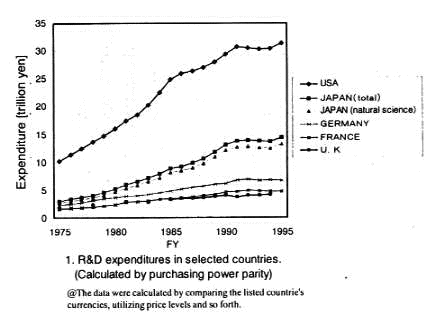
2.R&D expenditures for basic research of natural science.
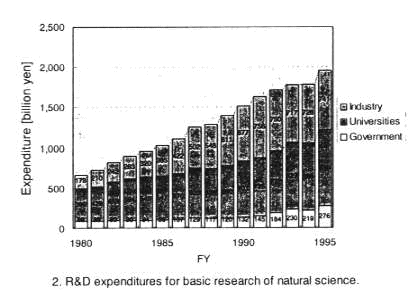
3.Ratio of R&D expenditures of natural science (FY 1995)
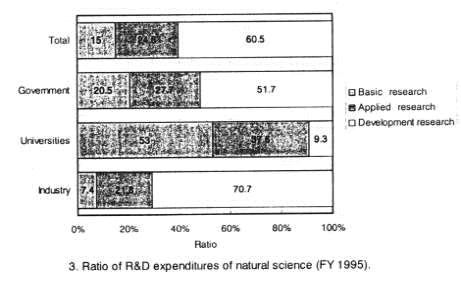
4.Budget for grants-in-aid for scientific research. (Ministry of Education, Science, Sports and Culture)
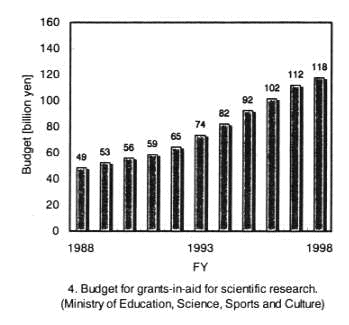
5.New programs for the promotion of strategic research.
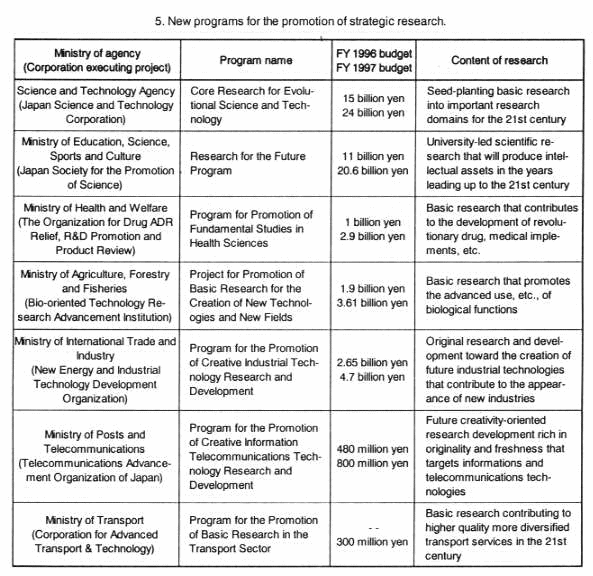
Copyright 2002 SCIENCE COUNCIL OF JAPAN